Tornado WEB服务器框架 Epoll-- 【模板】
4.2 使用模板
1. 路径与渲染
使用模板,需要仿照静态文件路径设置一样,向web.Application类的构造函数传递一个名为template_path的参数来告诉Tornado从文件系统的一个特定位置提供模板文件,如:
app = tornado.web.Application( [(r'/', IndexHandler)], static_path=os.path.join(os.path.dirname(__file__), "statics"), template_path=os.path.join(os.path.dirname(__file__), "templates"), )
在这里,我们设置了一个当前应用目录下名为templates的子目录作为template_path的参数。在handler中使用的模板将在此目录中寻找。
现在我们将静态文件目录statics/html中的index.html复制一份到templates目录中,此时文件目录结构为:
.
├── statics
│ ├── css
│ │ ├── index.css
│ │ ├── main.css
│ │ └── reset.css
│ ├── html
│ │ └── index.html
│ ├── images
│ │ ├── home01.jpg
│ │ ├── home02.jpg
│ │ ├── home03.jpg
│ │ └── landlord01.jpg
│ ├── js
│ │ ├── index.js
│ │ └── jquery.min.js
│ └── plugins
│ ├── bootstrap
│ │ └─...
│ └── font-awesome
│ └─...
├── templates
│
├--
在handler中使用render()方法来渲染模板并返回给客户端。
class TemplateStudyIndexHandler(web.RequestHandler): ''' 定义请求处理类 ''' def get(self, *args, **kwargs): '''测试模板用方法 ''' '''给模板传递变量''' house_info = { "price": 398, "title": "宽窄巷子+160平大空间+文化保护区双地铁", "score": 5, "comments": 6, "position": "北京市丰台区六里桥地铁" } self.render('templateStudyIndex.html',**house_info) #渲染类render('模板名',变量字典)
if __name__ == '__main__': options.parse_command_line() options.define('port', type=int, default=80, help='服务器端口') BASE_DIR = os.path.dirname(__file__) static_path = os.path.join(BASE_DIR,'statics') print(static_path) urls = [ (r'/',IndexHandler,), (r'/templateTest',TemplateStudyIndexHandler,), ] app = web.Application(urls, static_path=static_path,#给html中css js文件指定的获取路径=html中/static/ 这个url template_path=os.path.join(BASE_DIR,'templates'), #模板的目录配置 login_url='/login', debug=True) server = httpserver.HTTPServer(app) server.listen(options.port) ioloop.IOLoop.current().start()
2. 模板语法
2-1 变量与表达式
在tornado的模板中使用{{}}作为变量或表达式的占位符,使用render渲染后占位符{{XXX}}会被替换为相应的结果值。
我们将templateStudyIndex.html中的一条房源信息记录
<li class="house-item"> <a href=""><img src="/static/images/home01.jpg"></a> <div class="house-desc"> <div class="landlord-pic"><img src="/static/images/landlord01.jpg"></div> <div class="house-price">¥<span>398</span>/晚</div> <div class="house-intro"> <span class="house-title">宽窄巷子+160平大空间+文化保护区双地铁</span> <em>整套出租 - 5分/6点评 - 北京市丰台区六里桥地铁</em> </div> </div> </li>
改为模板:
<li class="house-item"> <a href=""><img src="/static/images/home01.jpg"></a> <div class="house-desc"> <div class="landlord-pic"><img src="/static/images/landlord01.jpg"></div> <div class="house-price">¥<span>{{price}}</span>/晚</div> <div class="house-intro"> <span class="house-title">{{title}}</span> <em>整套出租 - {{score}}分/{{comments}}点评 - {{position}}</em> </div> </div> </li>
渲染方式如下:
def get(self, *args, **kwargs): '''测试模板用方法 ''' '''给模板传递变量''' house_info = { "price": 398, "title": "宽窄巷子+160平大空间+文化保护区双地铁", "score": 5, "comments": 6, "position": "北京市丰台区六里桥地铁" } self.render('templateStudyIndex.html',**house_info) #渲染类render('模板名',变量字典)
{{}}不仅可以包含变量,还可以是表达式,如html语法中: {{p1 + p2}} 这种写法
<div class="house-price">¥<span>{{p1 + p2}}</span>/晚</div>
class IndexHandler(RequestHandler): def get(self): house_info = { "p1": 198, "p2": 200, "titles": ["宽窄巷子", "160平大空间", "文化保护区双地铁"], "score": 5, "comments": 6, "position": "北京市丰台区六里桥地铁" } self.render("index.html", **house_info)
--------------------------------展示模板渲染访问效果-------------------------------------------------------------
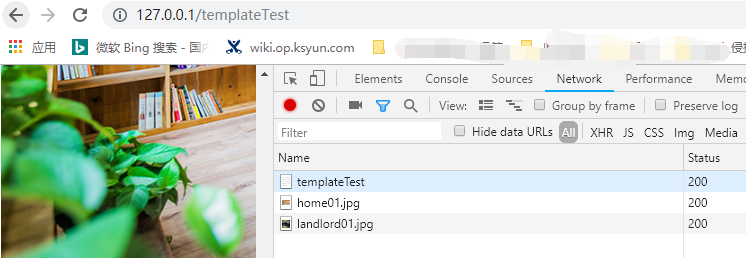
-------------------------------------------------The End-----------------------------------------------------------------------------------
2-2 控制语句
可以在Tornado模板中使用Python条件和循环语句。控制语句以{\%和\%}包围,并以类似下面的形式被使用:
{% if page is None %}
或
{% if len(entries) == 3 %}
控制语句的大部分就像对应的Python语句一样工作,支持if、for、while,注意end:
{% if ... %} ... {% elif ... %} ... {% else ... %} ... {% end %}
{% for ... in ... %} ... {% end %}
{% while ... %} ... {% end %}
示例html
<!DOCTYPE html> <html lang="en"> <head> <meta charset="UTF-8"> <title>模板控制语句测试页面</title> </head> <body> <ur class="house-list"> {% if len(houses) > 0 %} {% for house in houses %} <li class="house-item"> <a href=""><img src="/static/images/{{ house['image'] }}"></a> <div class="house-desc"> <div class="landlord-pic"><img src="/static/images/landlord01.jpg"></div> <div class="house-price">¥<span>{{ house["price"] }}</span>/晚</div> <div class="house-intro"> <span class="house-title">{{ house["title"] }}</span> <em>整套出租 - {{ house["score"] }}分/{{ house["comments"] }}点评 - {{ house["position"] }}</em> </div> </div> </li> {% end %} {% else %} 对不起,暂时没有房源!!! {% end %} </ur> </body> </html>
python中渲染语句为:
class TemplateControlStudyIndexHandler(RequestHandler): def get(self): houses = [ { "image": "home01.jpg", "price": 298, "title": "宽窄巷子+160平大空间+文化保护区双地铁", "score": 5, "comments": 6, "position": "北京市丰台区六里桥地铁" }, { "image": "home02.jpg", "price": 198, "title": "宽窄巷子+160平大空间+文化保护区双地铁", "score": 5, "comments": 6, "position": "北京市丰台区六里桥地铁" }, { "image": "home03.jpg", "price": 98, "title": "宽窄巷子+160平大空间+文化保护区双地铁", "score": 5, "comments": 6, "position": "北京市丰台区六里桥地铁" } ] houses = [] #此时无房源,注释后有房源 self.render("templateControlStudyIndex.html", houses=houses)
----------------------------------------------------------------------------------展示访问效果------------------------------------------------------------------------------------------------------------

---------------------------------------------------无房源展示-------------------------------------------------------------------

-----------------------------------------------------------------展示end-------------------------------------------------------------------------------------
2-3 函数
static_url()
Tornado模板模块提供了一个叫作static_url的函数来生成静态文件目录下文件的URL。如下面的示例代码:
<link rel="stylesheet" href="{{ static_url("style.css") }}">
这个对static_url的调用生成了URL的值,并渲染输出类似下面的代码:
<link rel="stylesheet" href="/static/style.css?v=fe8ccdaf962ce00b725138ef260cbf0c">

优点:
-
- static_url函数创建了一个基于文件内容的hash值,并将其添加到URL末尾(查询字符串的参数v)。这个hash值确保浏览器总是加载一个文件的最新版而不是之前的缓存版本。无论是在你应用的开发阶段,还是在部署到生产环境使用时,都非常有用,因为你的用户不必再为了看到你的静态内容而清除浏览器缓存了。
- 另一个好处是你可以改变你应用URL的结构,而不需要改变模板中的代码。例如,可以通过设置static_url_prefix来更改Tornado的默认静态路径前缀/static。如果使用static_url而不是硬编码的话,代码不需要改变。
转义--------------------------------------------------------------------------------------------------------------
我们新建一个表单页面transferred.html
<!DOCTYPE html> <html lang="en"> <head> <meta charset="UTF-8"> <title>Title</title> </head> <body> <form method="post" href="/transferred"> <textarea name="text"></textarea> <input type="submit" value="提交数据"> </form> {{ text }} </body> </html>
对应的handler为:
class TransferredHandler(RequestHandler): def get(self, *args, **kwargs): '''测试tornado对网页文字的自动转义功能''' self.render('transferred.html',text='') def post(self, *args, **kwargs): '''测试tornado对网页文字的自动转义功能''' text = self.get_argument('text','') print('获取到参数text:',text) self.render('transferred.html',text=text)
当我们在表单中填入如下内容时:
<script>alert("hello!");</script> :写入的js程序并没有运行,而是显示出来了,如下截图展示
--------------------------截图展示自动转义------------------------------------访问效果-------------------------------------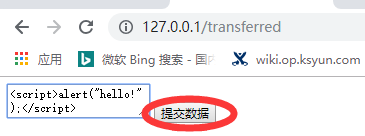

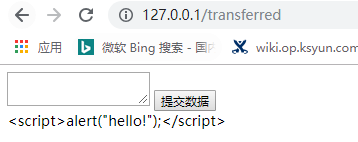
---------------------------------------------------------------------------------------------------------------------------------------------------------------------
我们查看页面源代码,发现<、>、"等被转换为对应的html字符:<script>alert("hello!");</script>
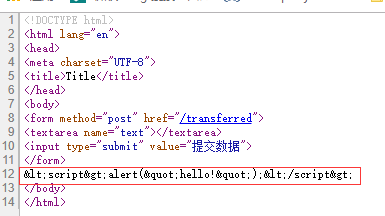

------------------------------------------------------------------------------------------------------------------------------------------------------------------------------------------------
这是因为tornado中默认开启了模板自动转义功能,防止网站受到恶意攻击。
我们可以通过raw语句来输出不被转义的原始格式,如:
<!DOCTYPE html> <html lang="en"> <head> <meta charset="UTF-8"> <title>Title</title> </head> <body> <form method="post" action="/transferred"> <textarea name="text"></textarea> <input type="submit" value="提交数据"> </form> {{ text }} {% raw text %} <!-- 这里设置浏览器执行网页输入的脚本--> </body> </html>
注意:在Firefox浏览器中会直接弹出alert窗口,而在Chrome浏览器中,需要set_header("X-XSS-Protection", 0)
def post(self, *args, **kwargs): '''测试tornado对网页文字的自动转义功能''' self.set_header("X-XSS-Protection", 0) text = self.get_argument('text','') print('获取到参数text:',text) self.render('transferred.html',text=text)

-------------------------------------------------------------------------------------------------------------------------------------------------------------------------------------------------------------------
关闭自动转义:,
方法一: 在Application构造函数中配置参数: autoescape=None,
app = web.Application(urls, static_path=static_path,#给html中css js文件指定的获取路径=html中/static/ 这个url template_path=os.path.join(BASE_DIR,'templates'), autoescape=None, login_url='/login', debug=True)
方法二:每页模板中修改自动转义行为,添加如下语句: {% autoescape None %} : 被注释的情况下仍然生效

<!DOCTYPE html> <html lang="en"> <head> <meta charset="UTF-8"> <title>测试自动转义</title> </head> <body> <form method="post" action="/transferred"> <textarea name="text"></textarea> <input type="submit" value="提交数据"> </form> {{ text }} {% autoescape None %} <!--{% raw text %} <!– 这里设置浏览器执行网页输入的脚本–>--> </body> </html>
escape():
关闭自动转义后,可以使用escape()函数来对特定变量进行转义,如:{{ escape(text) }}
注意:模板中
{{ escape(text) }} 并不会覆盖{% autoescape None %} 两者同时存在时先按照不转义处理,转义后的仍会被显示
自定义函数-----------------------------------------------------------------------------------------------------------------------
在模板中还可以使用一个自己编写的函数,只需要将函数名作为模板的参数传递即可,就像其他变量一样。
我们修改后端如下:
class SelfDefiningfunction(RequestHandler): def get(self): houses = [ { "image": "home01.jpg", "price": 298, "title": ["宽窄巷子"," 160平大空间","文化保护区双地铁"], "score": 5, "comments": 6, "position": "北京市丰台区六里桥地铁" } ] self.render("templateControlStudyIndex.html", houses=houses,title_join=house_title_join)
前端Html文件修改如下
<body> <ur class="house-list"> {% if len(houses) > 0 %} {% for house in houses %} <li class="house-item"> <!--<a href=""><img src="/static/images/{{ house['image'] }}"></a>--> <a href=""><img src="/static/images/{{house['image']}}"></a> <div class="house-desc"> <div class="landlord-pic"><img src="{{static_url('images/landlord01.jpg')}}"></div> <div class="house-price">¥<span>{{ house["price"] }}</span>/晚</div> <div class="house-intro"> <span class="house-title">{{ title_join(house["title"]) }}</span> <em>整套出租 - {{ house["score"] }}分/{{ house["comments"] }}点评 - {{ house["position"] }}</em> </div> </div> </li> {% end %} {% else %} 对不起,暂时没有房源!!! {% end %} </ur> </body>
=================================================================================================
2-4 块
我们可以使用块来复用模板,块语法如下:
{% block block_name %} {% end %}
现在,我们对模板index.html进行抽象,抽离出父模板base.html如下:
<!DOCTYPE html> <html> <head> <meta charset="utf-8"> <meta http-equiv="X-UA-Compatible" content="IE=edge"> <meta name="viewport" content="width=device-width, initial-scale=1, maximum-scale=1, user-scalable=no"> {% block page_title %}{% end %} <link href="{{static_url('plugins/bootstrap/css/bootstrap.min.css')}}" rel="stylesheet"> <link href="{{static_url('plugins/font-awesome/css/font-awesome.min.css')}}" rel="stylesheet"> <link href="{{static_url('css/reset.css')}}" rel="stylesheet"> <link href="{{static_url('css/main.css')}}" rel="stylesheet"> {% block css_files %}{% end %} </head> <body> <div class="container"> <div class="top-bar"> {% block header %}{% end %} </div> {% block body %}{% end %} <div class="footer"> {% block footer %}{% end %} </div> </div> <script src="{{static_url('js/jquery.min.js')}}"></script> <script src="{{static_url('plugins/bootstrap/js/bootstrap.min.js')}}"></script> {% block js_files %}{% end %} </body> </html>
而子模板subblock_index.html使用extends来使用父模板base.html,如下:
{% extends "base.html" %} {% block page_title %} <title>爱家-房源</title> {% end %} {% block css_files %} <link href="{{static_url('css/index.css')}}" rel="stylesheet"> {% end %} {% block js_files %} <script src="{{static_url('js/index.js')}}"></script> {% end %} {% block header %} <div class="nav-bar"> <h3 class="page-title">房 源</h3> </div> {% end %} {% block body %} <ul class="house-list"> {% if len(houses) > 0 %} {% for house in houses %} <li class="house-item"> <a href=""><img src="/static/images/home01.jpg"></a> <div class="house-desc"> <div class="landlord-pic"><img src="/static/images/landlord01.jpg"></div> <div class="house-price">¥<span>{{house["price"]}}</span>/晚</div> <div class="house-intro"> <span class="house-title">{{title_join(house["title"])}}</span> <em>整套出租 - {{house["score"]}}分/{{house["comments"]}}点评 - {{house["position"]}}</em> </div> </div> </li> {% end %} {% else %} 对不起,暂时没有房源。 {% end %} </ul> {% end %} {% block footer %} <p><span><i class="fa fa-copyright"></i></span>爱家租房 享受家的温馨</p> {% end %}
#渲染直接使用子页面 self.render("subblock_index.html", houses=houses,title_join=house_title_join)
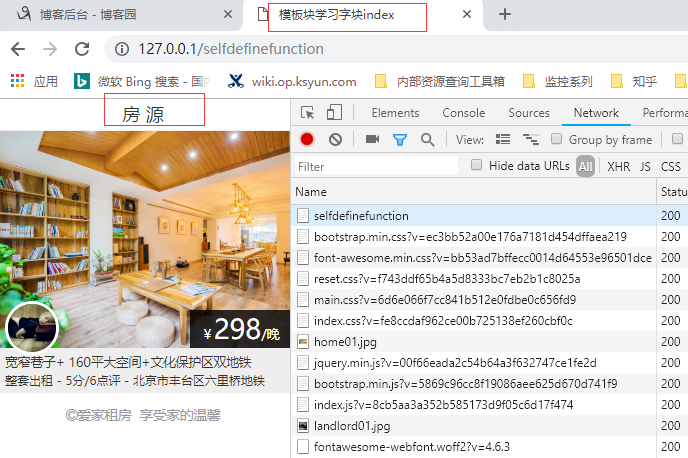
posted on 2020-03-01 21:47 zhangmingda 阅读(227) 评论(0) 编辑 收藏 举报




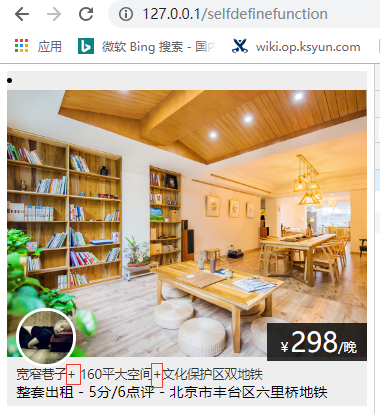



【推荐】国内首个AI IDE,深度理解中文开发场景,立即下载体验Trae
【推荐】编程新体验,更懂你的AI,立即体验豆包MarsCode编程助手
【推荐】抖音旗下AI助手豆包,你的智能百科全书,全免费不限次数
【推荐】轻量又高性能的 SSH 工具 IShell:AI 加持,快人一步
· 开发者必知的日志记录最佳实践
· SQL Server 2025 AI相关能力初探
· Linux系列:如何用 C#调用 C方法造成内存泄露
· AI与.NET技术实操系列(二):开始使用ML.NET
· 记一次.NET内存居高不下排查解决与启示
· 阿里最新开源QwQ-32B,效果媲美deepseek-r1满血版,部署成本又又又降低了!
· 开源Multi-agent AI智能体框架aevatar.ai,欢迎大家贡献代码
· Manus重磅发布:全球首款通用AI代理技术深度解析与实战指南
· 被坑几百块钱后,我竟然真的恢复了删除的微信聊天记录!
· AI技术革命,工作效率10个最佳AI工具